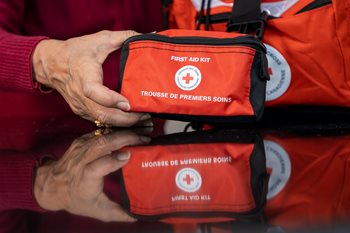 It’s undeniable; the amount of people working from home in the last few years has exponentially increased. While working from the comfort of our home has its share of advantages for many, there are also considerations to take when thinking about safety.
It’s undeniable; the amount of people working from home in the last few years has exponentially increased. While working from the comfort of our home has its share of advantages for many, there are also considerations to take when thinking about safety.Traditional workplaces have health and safety measures in place – such as workplace first aid kits, AED units, trained first aiders, monthly health and safety checks, etc. But how many of us have incorporated those safety measures in our home offices?
According to Statistics Canada, over 60% of Canadian employers are expecting that a portion of their employees will continue to work from home, meaning we should all make time to evaluate the safety of our work-from-home environment.
 Luckily, there are some easy steps you can take today to minimize risks and optimize safety in your home workplace:
Luckily, there are some easy steps you can take today to minimize risks and optimize safety in your home workplace:
- Have a first aid kit at home
- Participate in a first aid course to learn how to prevent, recognize and respond to common illness and injuries
- Establish a regular check-in procedure. If you work alone, you should always have regularly scheduled calls with a colleague or supervisor – if you don’t make the call, do they know how to reach you at an alternate number?
- Ensure your workstation design and space includes proper ergonomics, lighting, temperature, and air circulation. The Canadian Centre for Occupational Health and Safety provides some useful resources and tips
- Ensure fire protection measures are in place (smoke alarms, carbon monoxide detector, fire extinguisher, etc.)
- Have an emergency plan to be prepared in the event of a disaster or emergency
As an employer or supervisor, there are things you can do to maintain safety as a top priority, even when your team members work from home. Here is a useful checklist inspired by the Canadian Centre for Occupational Health and Safety:
- Stay informed of the regulations in your community. Some jurisdictions have specific laws for working alone
- Discuss risks with your team members. Get their input about the work they do, potential hazards and possible solutions
- Prevent or minimize potential risks of working alone by implementing solutions
- Provide appropriate training and education
- Ask for team members to report all incidents that happened during work hours
- Establish a check-in procedure. Make sure regular contact is kept with all workers
- Schedule higher risk tasks to be done during normal business hours, or when another worker capable of helping in an emergency is available.
The official Canadian Red Cross First Aid app is also a great tool for those wanting to be ready to face everyday emergencies that could happen while working from home. By downloading the app on your smartphone or tablet, you get instant access to videos, interactive quizzes and simple step-by-step advice to help you maintain your life-saving skills and respond when needed.
Related stories
Workplace changes and well-being: adapting to a new era
First Aid Basics: It’s made for you
Coping with crisis: What’s in your self-care plan?

